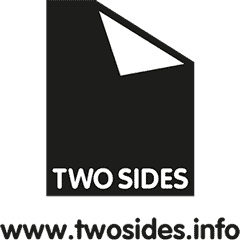This month we’re looking at the environmental impact of the print and paper industry.
In their booklet “Print and Paper, Myths and Facts”, the not-for-profit organisation Two Sides busts nine popular myths surrounding paper sustainability. “The European paper industry is a world leader when it comes to sustainably sourced raw materials, renewable energy and recycling rates,” it says.
Good news for marketing, fundraising and operations managers who already know the unique role direct mail plays in campaigns and business-critical mailings. A recent Marketreach/WARC report found that effective use of print media builds strong connections with consumers. Campaigns that use direct mail are 52% more likely to report return on investment (ROI) and 43% more likely to see revenue uplifts. And print delivers on your CSR credentials too.
Yet myths about the industry’s environmental impact still abound in the minds of consumers. We offset them with the facts here:
1 Paper is highly recycled and naturally sustainable
Myth: Paper is bad for the environment
Derived from wood, a natural resource grown in managed forests, paper is one of the most recycled products in the world. In 2020 a total of 56 million tonnes of paper were collected and recycled in Europe at a recycling rate of 74%.
For paper and cardboard packaging, recycling is even higher at 83%. Paper fibre is also recycled and reused on average 3.8 times. (Cepi, Key Statistics, 2021)
2 European forests are growing
Myth: Forests are shrinking
A 2021 survey by Two Sides revealed that 64% of European consumers believe forests are shrinking. In fact, between 2005 and 2020 European forests grew by 58,390 square kilometres – an area equivalent to the size of Switzerland, or 1,500 football pitches each day.
Forests currently cover 40% of Europe and over 90% of the European paper industry’s wood fibre originates from European forests.
“The most common pressures causing deforestation are large and small-scale agriculture, unsustainable logging, mining, infrastructure projects, and increased fire incidence and intensity.” (WWF, Deforestation Fronts website, 2018)
3 Sustainable Forest Management preserves biodiversity and safeguards forests
Myth: Planted forests are bad for the environment
The Forest Stewardship Council® (FSC®) and the Programme for the Endorsement of Forest CertificationTM (PEFCTM) are two organisations operating robust schemes tracking wood and wood fibre supply chains from the forest to consumer. They ensure the conservation of natural habitats for plants and animals, as well as respect for the rights of forestry workers and local communities.
Forests worldwide contain more than 60,000 different tree species. They are habitats for 80% of amphibian species, 75% of bird species and 68% of mammal species.
Over the last 37 years, there have been only minor fluctuations in the common forest bird index, indicating the overall stability of European forests and their biodiversity. (The State of Europe’s Forests, 2020)
Through recycling, and producing paper from sustainably managed forests, the paper industry is one of the lowest industrial greenhouse gas emitters in Europe accounting for just 0.8% of all emissions.
European Environment Agency
4 Most of the energy used in paper production is renewable – and carbon intensity is surprisingly low
Myth: Paper production is a major cause of Greenhouse Gas Emissions
Through recycling, and producing paper from sustainably managed forests, the industry is one of the lowest industrial greenhouse gas emitters in Europe accounting for just 0.8% of all emissions. This contrasts with much higher emitters like non-metallic mineral products at 5.6% and basic metal industries at 4.8%. (European Environment Agency, Annual European Union Greenhouse Gas Inventory 1990-2018, 2020)
During the period 1990-2019, the paper industry’s carbon emissions reduced by 48% per tonne of product.
The European pulp and paper industry is also the biggest single user and producer of renewable energy in Europe; with 62% of its primary energy consumption coming from renewable sources like biomass. Biomass can significantly reduce net carbon emissions when compared with fossil fuels. (Cepi, Key Statistics, 2020)
5 Virgin fibres from sustainably managed forests are needed to maintain the paper cycle
Myth: Only recycled paper should be used
Paper cannot be recycled indefinitely as fibres become short and worn. The papermaking process uses recycled fibre as effectively as possible adding in new or virgin wood fibre to maintain the strength, quality and availability of paper products.
The industry uses respected forestry certification schemes to ensure that fresh wood fibre is sourced from sustainably managed forests.
6 Electronic communication has environmental impacts
Myth: Electronic communication is better for the environment than paper-based communication
60% of European consumers believe the digital industry is better for the environment than print. But did you know research by the European Commission in 2020, found the ICT industry accounts for 5-9% of electricity use? This is more than 2% of global greenhouse gas emissions – as much as all air traffic! The Commission predicted the ICT footprint could rise to 14% of global emissions by 2040.
Other problems for the digital industry are a lack of recycling of non-renewable resources, use of precious resources, and a build-up of global e-waste stored in mega data centres, or Cloud services, equivalent to the weight of 350 cruise ships. (2019)

7 Paper Production is dependent on water – yet consumes relatively little
Myth: Paper production uses an excessive amount of water
It’s true, water is used throughout the papermaking process – firstly in producing the trees and wood that paper is made from; in making the paper itself; as treated effluent or wastewater from the manufacturing process.
The industry uses mostly naturally renewable surface water from rivers and lakes for 89% of its intake, compared to 4% from public water supplies.
The key factor is that intake does not equal consumption, because most of the water is returned to the environment. 93% of the water used in the European paper industry is returned in good quality (having been reused within the mill before being suitably treated).
Plus, the average water intake per tonne of paper has decreased by 47% since the 1990s.
8 The paper industry supports a circular economy
Myth: Paper wastes precious resources
Paper manufacturing uses the whole tree, and wood processing by-products including sawdust, forest thinnings, and sawmill chips.
In 2019, 55% of fuel used in the pulp and paper industry came from industry generated biomass from organic by-products of the manufacturing process. Only 17% came from fossil fuels and net-bought electricity.
In contrast to the linear Take-Make-Waste model of many industries, the circular model of the paper industry is based on Make-Use-Recycle-Reuse. This benefits businesses, society and the environment by replenishing and regenerating.
9 Consumers value paper-based communications
Myth: Digital communication is the preferred method of communication
Organisations are increasingly going online with their communications, sometimes charging customers if they wish to receive paper-based documents.
But the report from Marketreach/WARC found that even in today’s digital world print is a highly effective communications tool that delivers results. Direct mail receives more attention and stays around the home for longer. People enjoy reading print media; they often absorb information with greater ease than through digital channels and feel a higher degree of trust in what they read. After all, the paper and print industry has been the preferred communications medium for 2000 years – and it still is for many!
The move to online-only communications risks leaving the most vulnerable members of society disconnected. Two Sides believes that consumers need the choice of both postal and electronic communications.
So, print sustainability means you don’t need to worry about its environmental impact in your campaigns and business mailings. You can enjoy the advantages it brings.
Combined with the best environmental options for inks, paper quality, envelopes and carbon offsetting, Two Sides concludes, “From newspapers to magazines, from photocopies to leaflets, from letters to boxes, we believe print and paper cannot be beaten for attractiveness, impact and sustainability”. (Two Sides, 2021)
Read more
Print marketing? It’s greener than you think – read our previous blog on Print Sustainability
Find out more about Earth Day 2022
View the Two Sides research Print & Paper, Myths & Facts Booklet
Book a Free Sustainability Check
Have you thought about switching to environmentally friendly options for your print campaigns or business-critical mailings?
Talk to us about print sustainability including inks, paper, envelopes and carbon offsetting. Discover how sustainable your mailings could be with our free report and recommendations.





















